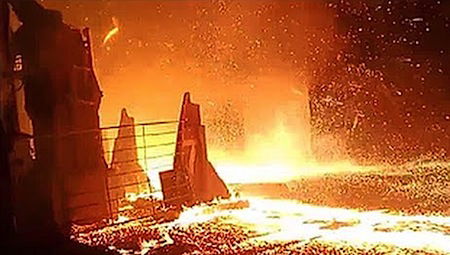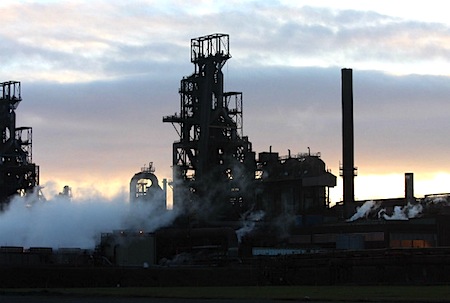Steel giant Tata has been fined £200,000 after three workers sustained serious burns when a ladle holding 300 tonnes of molten steel became detached from a crane, spilling its white hot load, which then ignited the factory floor. A simple two-hour camera repair could have prevented this fire, the subsequent enquiry found, but also the lighting needed improvement. By James Hunt:
Kevin Watts, a trainee crane operator, and two colleagues escaped the 2013 fire at the Tata Strip Products steelworks in Port Talbot, West Wales, by climbing out of the top of the crane and over the boom. This followed a major spillage of 300 tonnes of molten steel, in part because of a camera that wasn’t working. Lighting that failed completely during the accident did not help their escape.
The three employees suffered serious burns as a result. Watts had been operating the overhead electric crane under the supervision of two trainers. He picked up the full ladle of molten steel. As the crane’s camera system was not working (although this fault had previously been reported), he asked the plant control room to confirm that the crane’s hooks were properly attached to the ladle.
The reply was that one of the hooks was not fully attached. When the crane was reversed to ensure correct attachment, the ladle became detached, spilling the molten steel to the floor, where a fire quickly started that reached the crane’s cab, forcing the three men to escape.
At about this time, the plant’s lighting in the area failed completely, making escape still more difficult, and the three suffered serious burns.
Watts had severe burns on his head and forearms, spent some time in hospital and has since had problems with repeated infections and has not been able to return to work. His two colleagues were less severely burned and are back at work - although they don’t want to return to the area where the accident occurred.
Camera and lighting were problems
The subsequent Health & Safety Executive (HSE) investigation found that the crane’s camera system had not been working for some time. The fault had been reported and noted during pre-use checks, but the fault had not been remedied.
Furthermore, the investigation found that lighting in the area, which had been described by workers as ‘poor’, had failed completely during the fire – precisely of the opposite of what was desperately needed at the time of the accident.
Good emergency lighting crucial
Good emergency lighting might have helped these employees escape more easily from the scene of this accident after the failure of the lighting system.
The Industry Committee for Emergency Lighting (ICEL -
www.icel.co.uk), which is the emergency lighting arm of the Lighting Industry Association (LIA), exists to strengthen the industry and promote the benefits of good quality emergency lighting by representing all aspects of UK, EU and international legislation and standards at the highest level.
ICEL can identify the required criteria for escape route lighting, anti-panic lighting and high-risk task lighting. Emergency lighting is most commonly associated with loss of the normal mains supply, but accidents and fire – like this serious Tata incident - can cause the normal lighting to fail. This is precisely why installing, regularly testing and maintaining a good emergency lighting system – like those available from ICEL member firms – is essential.
Poor maintenance
Swansea Crown Court fined Tata Steel – which has a history of safety failures - £200,000 and ordered it to pay costs of £11,190 after it pleaded guilty to breaching of Section 2(1) of the Health and Safety at Work Act.
Commented HSE inspector Joanne Carter: “There was clear evidence at Tata Steel of poor maintenance, inconsistent training and managers misunderstanding the problems faced by operators.
“Given the potential consequences of a ladle holding 300 tonnes of molten metal spilling its load onto the floor, control measures should be watertight,” she said.
Since the incident, Tata has fixed the crane’s camera system, improved the lighting and ensured managers scrutinise pre-use checks.

